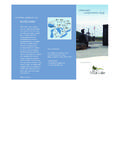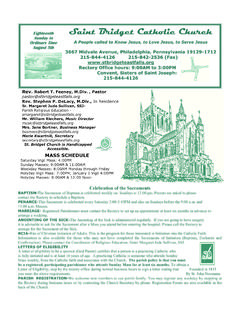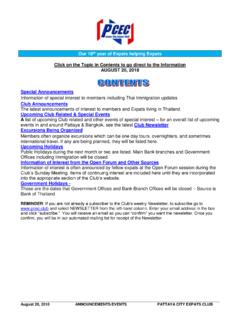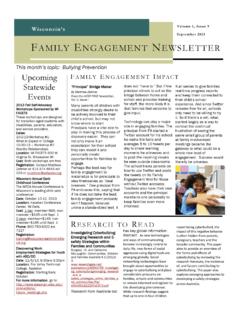Transcription of WHEN VICE WAS KING
1 when vice WAS king A HISTORY OF NORTHERN KENTUCKY GAMBLING 1920-1970 by Jim Linduff with Roy Klein and Larry Trapp Revision 1 May 23, 2012 CONTENTS Preface Chapter 1 INTRODUCTION History of Region Chapter 2 MAJOR PLAYERS Cleveland Syndicate, (Dalitz, Tucker, Rothkopf, Kleinman) New York Mob, (Levinsons, Bermans, Screw Andrews) Locals Bootleggers, (Remus, Schmidt, Brady, Masterson, Farleys) Independents, (Dennert, Harris, Brink, Bridewells) Layoff Operators, (Lassoffs, Devine, Beckley) Other minor players Chapter 3 MAJOR CLUBS Beverly Hills Flamingo/633 Club Glenn Hotel/ Glenn Rendezvous Glenn Schmidt Playtorium/ Snax Bar Hi-De-Ho/19 Club Latin Quarter/Primrose Club/Bluegrass Inn Lookout House Merchant s Club Yorkshire Chapter 4 MINOR CLUBS 222 Club 316 Club 514 Club Avenue Nite club Barney s Old Homestead Carr s Corner Club Alexandria Club Kenton Columbia Caf Dog House/Dog Pound Golden Horseshoe Guys & Dolls Haidi Club Jockey Club Kentucky Club Kid Able Club/Monmouth Cigar Magnolia Hotel Mecca Melbourne Country Club Orr s Caf Press Club Ray s Caf Rocket Club Sandwich Shop Stag Caf Stark/Stork/Stardust/Silver Slipper/Galaxie Tin Shack Turf Club Woodland Inn Chapter 5 NEWPORT
2 CENTRAL AVENUE CLUBS Chapter 6 REFORM MOVEMENT Ratterman , Committee of 500 Chapter 7 CHIP SUMMARY Chapter 8 MISCELLANEOUS PHOTOS Notes SOURCES PREFACE Much has been written about organized crime in the United States, primarily about activities in major cities: New York, the city of origin; Chicago, home of Al Capone; Miami; Tampa; New Orleans, with its possible connections to the assassination of John F. Kennedy; and of course, Las Vegas, the city that crime built. Northern Kentucky has been included in some studies, most notably by Hank Messick, the crusading investigative reporter for the Louisville Courier-Journal who made his career writing about the illegal activities there. Several excellent articles listed in the Sources section of this article have described the Northern Kentucky scene, some including descriptions of chips, dice and other memorabilia of interest to collectors.
3 Why then, our article? We asked this question several times throughout the project as we searched for long-forgotten references and recollections of clubs, some not being in the news for over 60 years! First, and of most importance to us, is our need to further document the people and locations that made the Northern Kentucky gambling era unique. Also, as collectors, we are a scurvy lot who never stop looking for new finds--a chip not previously known to be at a given joint, dice that surface from places not thought to have had gambling at all, ash trays, dinnerware, swizzle the stuff we keep and share with others. If these new treasures evoke some jealousy in our fellow collectors, so be it! We certainly aren t in it for the money! God knows we buy way more than we ever sell.
4 Finally, we view our work as a continuing process. We believe we have updated and significantly expanded the knowledge of both the people and places in the Northern Kentucky gambling history. We have also tried to further describe how and why Northern Kentucky became a gambling center and to what extent the reform actually helped the area. Our section listing chips from the area will certainly be challenged, but it represents our best effort to provide a summary of the authenticated and undocumented chips from each location. We have not tried to place values on the chips, as these tend to change frequently as new batches are found, and because they are worth what someone is willing to pay at a given time. It is our hope that others will correct and update what we have done so that information about the area will not be lost over time.
5 A first addendum is included in this addition, but there is certainly more to come. It s been fun putting this together and we welcome comments. We want to fully credit and acknowledge the valuable help we received from Gene Trimble, Dave Horn, Ed Hertel, Allen Meyers, Rich Ritchie, Lou Coletti and many others in the Casino Chip and Gaming Token Collectors Club. Their written work and answers to our questions were a vital part of our study. Chapter 1 INTRODUCTION The scope of this study begins in about 1920, the start of Prohibition. While gambling and prostitution thrived in the Northern Kentucky region prior to 1920, particularly during the Civil War, as prostitutes and gambling halls serviced the soldiers stationed in Cincinnati, the influence of organized crime in the area caused gambling to flourish in the 1920s and into the 1930s.
6 During Prohibition, criminal activities became more respectable to citizens who demanded alcohol and the gambling associated with it. Large amounts of capital became available to buy and/or build distilleries, distribute the booze made therein throughout the Midwest and establish lavish carpet joints for people to drink and gamble. Northern Kentucky was near the booze supply, centrally located for distribution and its public officials had a history of looking the other way. One of the first major players in the bootlegging business was George Remus who came to Cincinnati from Chicago in 1920. While he had little direct influence in the gambling and prostitution business, he built a massive bootlegging operation in the early Prohibition days and many people in his organization became players in Northern Kentucky during later years.
7 It took the Cleveland Syndicate to jumpstart gambling in Northern Kentucky. The Cleveland Syndicate became part of a nationwide mob organization that controlled illicit activities coast to coast. The Cleveland Syndicate received the Ohio/Northern Kentucky area at the first national Organized Crime Commission in 1928. The Syndicate became one of the most powerful outfits in the country. The Cleveland Syndicate was first headquartered in Cincinnati at the Arrowhead Inn, in Branch Hill, Ohio, east of town. Joseph Bauer, an independent gambler, started the Arrowhead Inn in the late 1920s and ran it free from interference until 1932 when the Syndicate took over and put Sam Nason in as operator. In 1937 reform officials raided the joint and shut it down. Nason, a local with Syndicate ties moved to Elmwood Place in 1933, first at the Valley Walk-A-Show club, then to the Fox and Crow in Montgomery in 1944.
8 The Syndicate turned attention to the Coney Island Race Track in Cincinnati. The track was opened in 1925 and had Eastern mob ties. Dutch Schultz, a member of the Eastern mob took over the track operation in 1932. After he was gunned down in Newark in 1935, the Cleveland Syndicate took over and renamed the track River Downs. The Syndicate entered Northern Kentucky, first by taking over Latonia Park and a dog track in Florence. In the mid-1930s, they acquired Beverly Hills and the Lookout House from locals and began what was to become an almost total takeover of gambling in Northern Kentucky. Chapter 2 MAJOR PLAYERS CLEVELAND SYNDICATE Moe Dalitz--head of Cleveland Syndicate Sam Tucker--operated boats that ran booze from Canada Louis Rothkopf--ran booze stills Morris Kleinman--ran brewery in Cleveland Modern organized crime began in 1920 with Prohibition.
9 Meyer Lansky and Lucky Luciano were the national heads. The Cleveland Syndicate received the Kentucky area at the first Organized Crime Commission in 1928. Also known as the Cleveland Four, the Syndicate was one of the most powerful crime outfits in the United States. The four heads each brought specific skills to the organization led by Dalitz who came to Cleveland from Detroit where he was a member of the Purple Gang, the crime syndicate there. Originally the Cleveland Syndicate was involved in bootlegging liquor from Canada and distributing it nationwide in the United States. Gambling and illegal casinos followed in the 1930s and 1940s and by the 1950s the Cleveland Syndicate was deeply involved with the expansion of Las Vegas enterprises. NEW YORK AND OTHER MOB INFLUENCES The Levinsons: Ed, Mike, Sleepout Louis --from Detroit.
10 They came to Newport by way of Chicago in the late 1930s and took over the Flamingo/633 from Art Dennert. The Millers: Berman, Joe and Martin-- from New York. They took over the Yorkshire from Jimmy Brink in 1944. Screw Andrews A Cincinnati numbers runner, Andrews took over Black joints in Newport. Andrews was involved with all aspects of illegal operations in Northern Kentucky and associated with both the Eastern and Cleveland Syndicates. The Payne Brothers: Charles, Steve, Larkin (Ollie, Bull) The brothers were active in local crime since the 1930s. Steve Payne was killed in 1948 as part of Screw Andrews s takeover of Black Newport numbers and bar business. Screw hired both remaining brothers in his Central Avenue joints. Bull was killed by Melvin Clark in 1952, Charles died of natural causes in the early 1950s.



